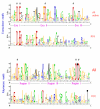Evolution of DNA polymerases: an inactivated polymerase-exonuclease module in Pol epsilon and a chimeric origin of eukaryotic polymerases from two classes of archaeal ancestors
- PMID: 19296856
- PMCID: PMC2669801
- DOI: 10.1186/1745-6150-4-11
Evolution of DNA polymerases: an inactivated polymerase-exonuclease module in Pol epsilon and a chimeric origin of eukaryotic polymerases from two classes of archaeal ancestors
Abstract
Background: Evolution of DNA polymerases, the key enzymes of DNA replication and repair, is central to any reconstruction of the history of cellular life. However, the details of the evolutionary relationships between DNA polymerases of archaea and eukaryotes remain unresolved.
Results: We performed a comparative analysis of archaeal, eukaryotic, and bacterial B-family DNA polymerases, which are the main replicative polymerases in archaea and eukaryotes, combined with an analysis of domain architectures. Surprisingly, we found that eukaryotic Polymerase epsilon consists of two tandem exonuclease-polymerase modules, the active N-terminal module and a C-terminal module in which both enzymatic domains are inactivated. The two modules are only distantly related to each other, an observation that suggests the possibility that Pol epsilon evolved as a result of insertion and subsequent inactivation of a distinct polymerase, possibly, of bacterial descent, upstream of the C-terminal Zn-fingers, rather than by tandem duplication. The presence of an inactivated exonuclease-polymerase module in Pol epsilon parallels a similar inactivation of both enzymatic domains in a distinct family of archaeal B-family polymerases. The results of phylogenetic analysis indicate that eukaryotic B-family polymerases, most likely, originate from two distantly related archaeal B-family polymerases, one form giving rise to Pol epsilon, and the other one to the common ancestor of Pol alpha, Pol delta, and Pol zeta. The C-terminal Zn-fingers that are present in all eukaryotic B-family polymerases, unexpectedly, are homologous to the Zn-finger of archaeal D-family DNA polymerases that are otherwise unrelated to the B family. The Zn-finger of Polepsilon shows a markedly greater similarity to the counterpart in archaeal PolD than the Zn-fingers of other eukaryotic B-family polymerases.
Conclusion: Evolution of eukaryotic DNA polymerases seems to have involved previously unnoticed complex events. We hypothesize that the archaeal ancestor of eukaryotes encoded three DNA polymerases, namely, two distinct B-family polymerases and a D-family polymerase all of which contributed to the evolution of the eukaryotic replication machinery. The Zn-finger might have been acquired from PolD by the B-family form that gave rise to Pol epsilon prior to or in the course of eukaryogenesis, and subsequently, was captured by the ancestor of the other B-family eukaryotic polymerases. The inactivated polymerase-exonuclease module of Pol epsilon might have evolved by fusion with a distinct polymerase, rather than by duplication of the active module of Pol epsilon, and is likely to play an important role in the assembly of eukaryotic replication and repair complexes.
Figures





Similar articles
-
Evolutionary connection between the catalytic subunits of DNA-dependent RNA polymerases and eukaryotic RNA-dependent RNA polymerases and the origin of RNA polymerases.BMC Struct Biol. 2003 Jan 28;3:1. doi: 10.1186/1472-6807-3-1. Epub 2003 Jan 28. BMC Struct Biol. 2003. PMID: 12553882 Free PMC article.
-
Crystal structure of an archaebacterial DNA polymerase.Structure. 1999 Oct 15;7(10):1189-99. doi: 10.1016/s0969-2126(00)80053-2. Structure. 1999. PMID: 10545321
-
Evolution of replicative DNA polymerases in archaea and their contributions to the eukaryotic replication machinery.Front Microbiol. 2014 Jul 21;5:354. doi: 10.3389/fmicb.2014.00354. eCollection 2014. Front Microbiol. 2014. PMID: 25101062 Free PMC article. Review.
-
Evolution of Eukaryotic DNA Polymerases via Interaction Between Cells and Large DNA Viruses.J Mol Evol. 2015 Aug;81(1-2):24-33. doi: 10.1007/s00239-015-9690-z. Epub 2015 Jul 16. J Mol Evol. 2015. PMID: 26177821
-
Archaeal DNA replication: identifying the pieces to solve a puzzle.Genetics. 1999 Aug;152(4):1249-67. doi: 10.1093/genetics/152.4.1249. Genetics. 1999. PMID: 10430556 Free PMC article. Review.
Cited by
-
Structure of the polymerase ε holoenzyme and atomic model of the leading strand replisome.Nat Commun. 2020 Jun 22;11(1):3156. doi: 10.1038/s41467-020-16910-5. Nat Commun. 2020. PMID: 32572031 Free PMC article.
-
The origin and early evolution of eukaryotes in the light of phylogenomics.Genome Biol. 2010;11(5):209. doi: 10.1186/gb-2010-11-5-209. Epub 2010 May 5. Genome Biol. 2010. PMID: 20441612 Free PMC article.
-
Human Pol ζ purified with accessory subunits is active in translesion DNA synthesis and complements Pol η in cisplatin bypass.Proc Natl Acad Sci U S A. 2014 Feb 25;111(8):2954-9. doi: 10.1073/pnas.1324001111. Epub 2014 Jan 21. Proc Natl Acad Sci U S A. 2014. PMID: 24449906 Free PMC article.
-
Architecture of the Saccharomyces cerevisiae Replisome.Adv Exp Med Biol. 2017;1042:207-228. doi: 10.1007/978-981-10-6955-0_10. Adv Exp Med Biol. 2017. PMID: 29357060 Free PMC article. Review.
-
CMG-Pol epsilon dynamics suggests a mechanism for the establishment of leading-strand synthesis in the eukaryotic replisome.Proc Natl Acad Sci U S A. 2017 Apr 18;114(16):4141-4146. doi: 10.1073/pnas.1700530114. Epub 2017 Apr 3. Proc Natl Acad Sci U S A. 2017. PMID: 28373564 Free PMC article.
References
-
- Kornberg A, Baker T. DNA Replication. 2. New York, NY: W. H. Freeman and Co; 1992.
-
- Johnson A, O'Donnell M. Cellular DNA replicases: components and dynamics at the replication fork. Annu Rev Biochem. 2005;74:283–315. - PubMed
-
- Iyer LM, Balaji S, Koonin EV, Aravind L. Evolutionary genomics of nucleo-cytoplasmic large DNA viruses. Virus Res. 2006;117:156–184. - PubMed
-
- Goodman MF, Tippin B. The expanding polymerase universe. Nat Rev Mol Cell Biol. 2000;1:101–109. - PubMed
-
- Pavlov YI, Shcherbakova PV, Rogozin IB. Roles of DNA polymerases in replication, repair, and recombination in eukaryotes. Int Rev Cytol. 2006;255:41–132. - PubMed
Publication types
MeSH terms
Substances
Grants and funding
LinkOut - more resources
Full Text Sources

